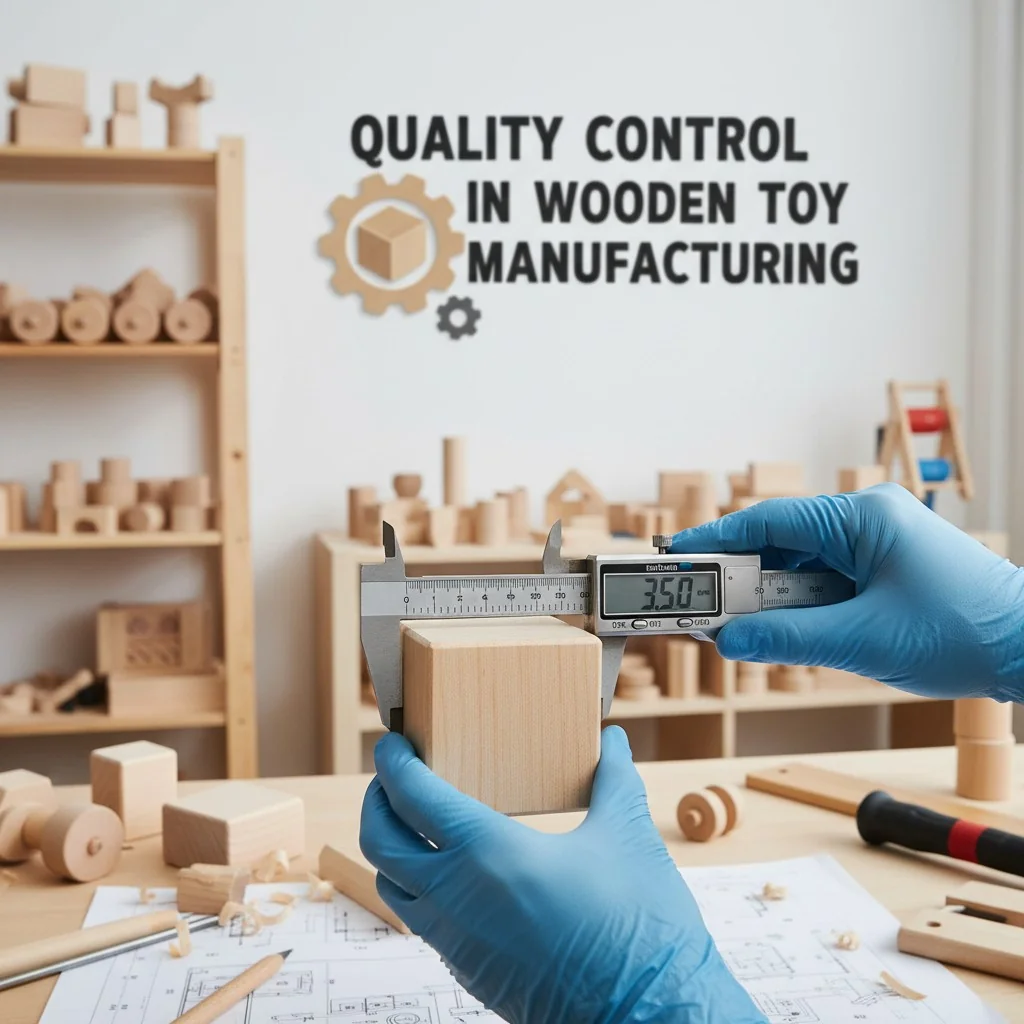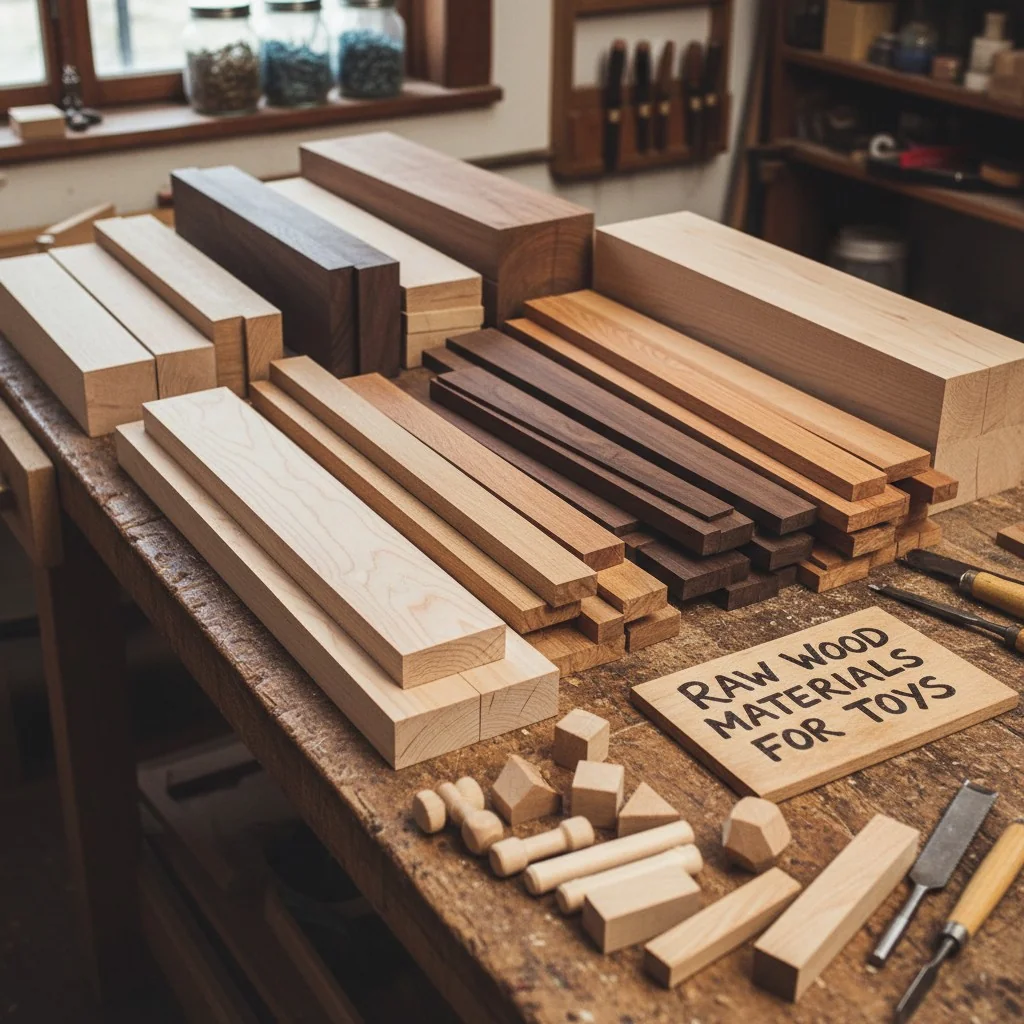
Worried about inconsistent quality from your wooden toy supplier? Poor quality leads to returns, bad reviews, and even safety risks, damaging your brand's reputation and bottom line.
To control quality, manufacturers must implement a multi-stage process. This includes strict raw material inspection[^1] for moisture and defects, in-process checks during cutting and sanding, rigorous testing of paints for safety, and final product verification against design specifications and international safety standards.

When I first transitioned from the world of high-precision molds to consulting for other manufacturing sectors, I was surprised by a common oversight. Many new importers focus only on the final product. They forget that a perfect wooden toy doesn't just appear at the end of the line; it's built with quality at every single step. It reminds me of making a complex mold—if your initial steel block is flawed, no amount of expert machining can save it. The same principle applies directly to wooden toys. You must start with the foundation. Let's break down the entire quality control process[^2], so you can work with your supplier like a pro and ensure every toy is a masterpiece.
All types of wood are equally suitable for making children's toys.False
Woods like pine are soft and can splinter easily, posing a safety risk. Hardwoods like maple, beech, and birch are preferred for their durability and smooth finish.
The moisture content of wood must be controlled to prevent toys from warping or cracking.True
Ideally, wood for toys should have a moisture content of 6-8%. This stability is crucial for parts that need to fit together precisely and to ensure the toy's longevity.
How Do You Guarantee Quality from the Very First Step: Raw Materials?
Sourcing wooden toys but unsure about the material quality? Receiving a batch made from cracked or unsuitable wood can halt your entire business and lead to massive waste.
The key is a strict incoming material inspection. This involves checking the wood species, verifying moisture content[^3] is between 6-8%, and rejecting any timber with knots, cracks, or insect damage. This first step prevents most downstream quality problems before they even start.

I remember a client who wanted to produce a set of custom wooden building blocks. They found a supplier with a great price, but a few months after launch, they were flooded with complaints. The blocks were warping and no longer stacked properly. The problem? The factory used wood with over 15% moisture content to save on drying time. From my CNC and mold-making background, I know that material stability is everything. We implemented a simple but non-negotiable rule: every batch of raw wood had to be checked with a moisture meter. It's a small step that makes a huge difference.
Incoming Quality Control (IQC) for Wood
Your first checkpoint is the raw material. A detailed IQC process ensures you're building with the best foundation.
- Species Verification: Ensure the supplier is using the agreed-upon wood (e.g., Beech, Maple). Different woods have different densities, grains, and durability.
- Moisture Content: This is critical. Use a digital moisture meter to check. High moisture leads to warping; low moisture can cause cracking.
- Visual Inspection: Look for natural defects that compromise the toy's integrity and safety.
Here is a simple checklist for your supplier:
| Inspection Point | Acceptance Criteria | Tool Required |
|---|---|---|
| Wood Species | Matches specification (e.g., Beech) | Visual / Documentation |
| Moisture Content | 6% - 8% | Digital Moisture Meter |
| Knots | No loose or large knots | Visual |
| Cracks / Splits | None allowed | Visual |
| Insect Damage | No holes or tunnels | Visual |
| Color Consistency | Uniform color within the batch | Visual |
Wood with a moisture content of 20% is acceptable for toy manufacturing.False
Wood with 20% moisture content is considered 'green' and is highly unstable. It will shrink, warp, and crack as it dries, making it completely unsuitable for quality toys.
Beechwood is a popular choice for wooden toys because it is hard, durable, and has a fine, straight grain that resists splintering.True
These properties make Beechwood safe for children and ideal for creating smooth, long-lasting toys that can withstand rough play.
What In-Process Checks are Crucial During Manufacturing?
Your raw materials are perfect, but how do you prevent errors during production? A single machine miscalibration can ruin thousands of parts, causing costly delays and rework.
Implement In-Process Quality Control (IPQC) at key stages. This means regularly checking dimensions after cutting, ensuring smoothness after sanding, and verifying hole placements. Use calipers and gauges to compare parts against the approved 3D/2D drawings, catching deviations early.

In my CNC business, we live by the rule: "measure twice, cut once." But in mass production, it's more like "cut one, measure it, then cut the next 10,000." I helped a client who was making wooden puzzles. The pieces from one batch just wouldn't fit together. We traced the problem to a CNC router bit that had worn down halfway through the production run, changing the dimensions by a fraction of a millimeter. It was a tiny change, but it made the whole puzzle useless. Now, they have a protocol to check the dimensions of a part every 100 units and change the router bits on a strict schedule. This is the kind of process control that separates the amateurs from the professionals.
IPQC: Maintaining Precision on the Line
Once production begins, you need checkpoints to maintain consistency.
Cutting and Machining
This is where the toy's basic shape and dimensions are defined. Precision is key, especially for parts that need to interlock.
- First Article Inspection (FAI): Before mass production, thoroughly inspect the very first part off the line against the design drawings.
- Dimensional Checks: Use digital calipers to periodically measure critical dimensions (length, width, diameter) of parts during the production run.
- CNC program verification[^4]: Ensure the correct CNC program is loaded for the specific part being made.
Sanding and Smoothing
This stage is crucial for safety and aesthetics. No child should ever get a splinter from a toy.
- Surface Roughness: Check for a consistently smooth finish. There should be no rough patches, machine marks, or splinters.
- Edge and Corner Sanding: All edges and corners must be rounded and smooth to the touch to prevent injuries.
Here’s a sample IPQC schedule:
| Process Stage | Checkpoint | Frequency | Tool |
|---|---|---|---|
| CNC Cutting | Critical dimensions (e.g., axle hole) | Every 100 pieces | Digital Caliper |
| Sanding | Surface smoothness, no splinters | Every 50 pieces | Visual & Touch |
| Drilling | Hole position and diameter | Every 100 pieces | Caliper, Pin Gauge |
Sanding wooden toys is only for aesthetic purposes.False
Sanding is a critical safety step. It removes splinters and sharp edges that could injure a child, and it prepares the surface for a safe and durable paint finish.
Using a Go/No-Go gauge is an efficient way to check hole diameters in mass production.True
A Go/No-Go gauge is a simple tool that allows an operator to quickly verify if a hole is within its specified tolerance range, making it much faster than using calipers for every part.
How Can You Ensure Safety and Durability in Finishing and Assembly?
The toy is shaped and sanded, but now comes the most sensitive part: finishing. Using the wrong paint can introduce toxic chemicals, and weak assembly can create choking hazards.
Mandate the use of paints and varnishes that are certified non-toxic and compliant with international standards like ASTM F963 (USA) and EN-71 (Europe). For assembly, conduct pull tests[^5] on small parts to ensure they cannot be detached and become choking hazards.

This is an area where you can take absolutely no shortcuts. I once consulted for a company whose shipment of wooden animals was rejected by customs. The lab report showed excessive lead in the paint. The factory manager swore he used "toy-safe" paint. The problem was his paint supplier gave him a fake certificate. The financial loss was huge, but the potential harm to children was unthinkable. Now, I advise all my clients to not only demand certificates but also to send paint samples from the actual production batch to an independent third-party lab for testing. Trust, but verify, especially when it comes to children's safety.
Finishing, Assembly, and Final Quality Control (FQC)
This is the final stage before packaging, where the product comes together and its safety is locked in.
Painting and Finishing
The finish must be beautiful, durable, and above all, safe.
- Paint/Varnish Certification: Always demand and verify the safety certificates for all paints and finishes. The certificate should prove compliance with EN-71 and ASTM F963 standards for heavy metals and toxic elements.
- adhesion test[^6]: After the paint is dry, perform a cross-hatch adhesion test. This involves scoring the paint and using tape to see if it flakes or peels off. Poor adhesion means the paint could chip off and be ingested.
- Color Consistency: Compare the finished toy's color against the approved master sample under controlled lighting.
Assembly and Durability
The toy must be able to withstand play.
- Pull Test: For any small parts attached to the main toy (e.g., wheels, a doll's hat), use a force gauge to perform a pull test to ensure they cannot be easily detached.
- Torque Test: For parts that are screwed on, a torque test ensures they are tight enough not to come loose.
- Drop Test: Drop a sample toy from a specified height (e.g., 1 meter) onto a hard surface multiple times to check for any breakage or parts falling off.
| Safety Standard | Key Focus Area | Region |
|---|---|---|
| ASTM F963 | Heavy metals (lead, cadmium), small parts, sharp points | USA |
| EN-71 | Similar to ASTM, with specific parts for chemicals, flammability, etc. | Europe |
| ISO 8124 | International standard largely harmonized with ASTM/EN-71 | Global |
A paint supplier's certificate is always sufficient proof of safety.False
Certificates can be forged or outdated. The best practice is to independently test a sample from the actual paint batch being used for your production run at a certified lab.
The ASTM F963 standard includes a 'small parts' test to prevent choking hazards for children under three.True
The test uses a cylinder of a specific size. If a toy or any piece that detaches from it fits entirely within the cylinder, it is deemed a choking hazard.
Conclusion
Controlling wooden toy quality requires a systematic, multi-stage approach. From raw materials to final packaging, every step needs verification to ensure safety, durability, and customer satisfaction.
References
[^1]: Raw material inspection is crucial to prevent quality issues and ensure the safety of wooden toys.
[^2]: Understanding the quality control process is essential for ensuring safety and durability in wooden toys.
[^3]: Controlling moisture content is vital to prevent warping and cracking in wooden toys.
[^4]: CNC program verification is key to maintaining precision and quality in the production of wooden toys.
[^5]: Pull tests are important to ensure that small parts of toys are securely attached and safe for children.
[^6]: An adhesion test ensures that the paint on wooden toys is durable and safe, preventing chipping.
